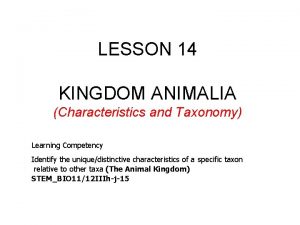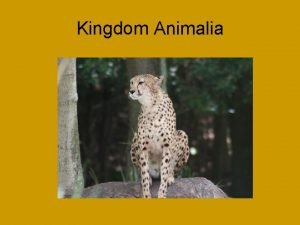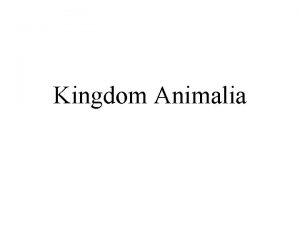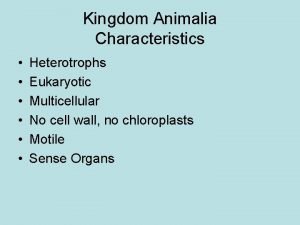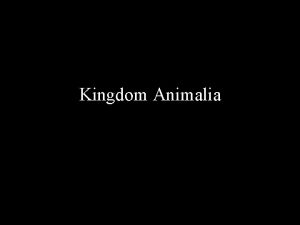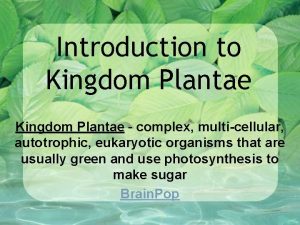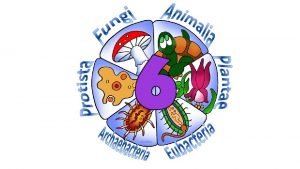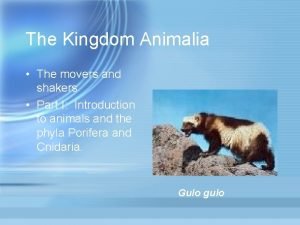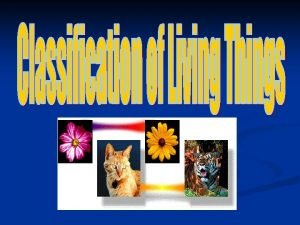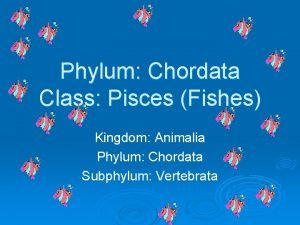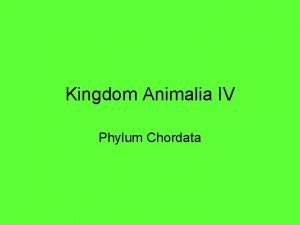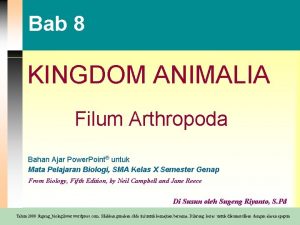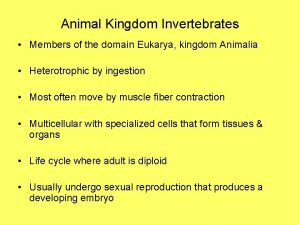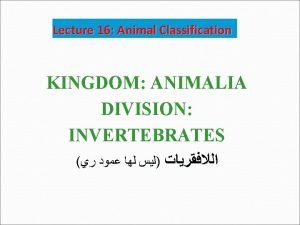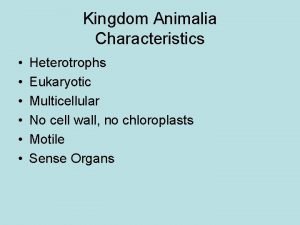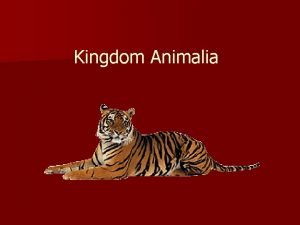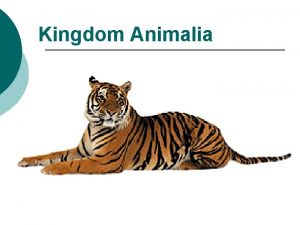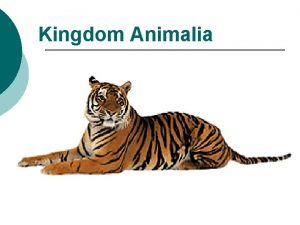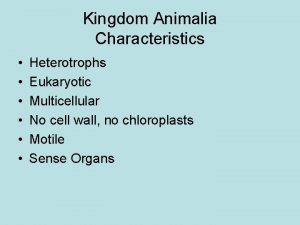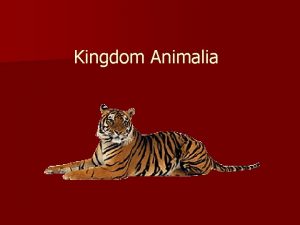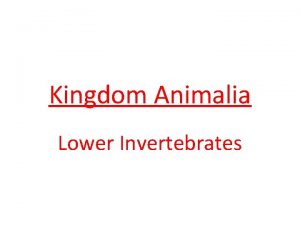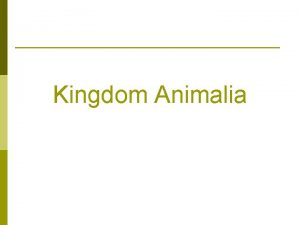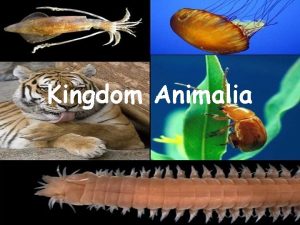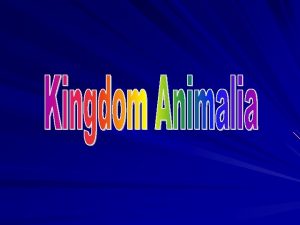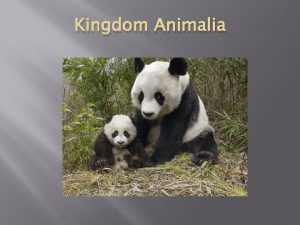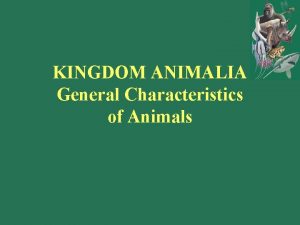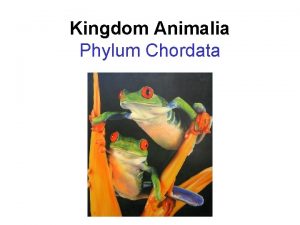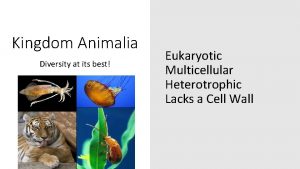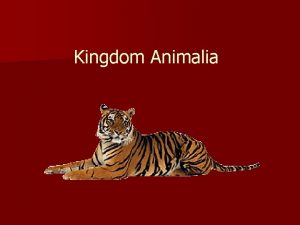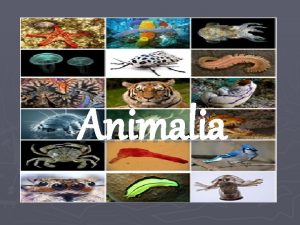Kingdom Animalia Characteristics n Multicellular Eukaryotic with no





















- Slides: 21

Kingdom Animalia

Characteristics n Multicellular Eukaryotic with no cell walls n Heterotrophs (consumers) n Have a nervous system to respond to their environment n. Locomotion relates to ability to obtain food n

Protection and Support n Though not all animals have a skeleton, those that do can be divided into two groups: – Those with an exoskeleton – a hard, waxy coating on the outside of the body that protects internal organs, provides a framework for support, and a place for muscle attachment. – Those with an endoskeleton – support framework within the body that protects some organs and a brace for muscles to pull against.

In the Animal Kingdom there are 9 Phyla • Porifera • Cnidaria • Platyhelminthes • Nematoda • Annelida • Mollusca • Echinoderm • Arthropoda • Chordate

Phylum Porifera n Sponges n simplest form of animal life n live in water n Do not move around n no symmetry n Pores (holes) all over body n Examples: Tube Sponge, Glass Sponge, Sea Sponge

Phylum Cnidaria or Coelenterata n Live in water n Most have tentacles n catch food with stinging cells n Examples - Jellyfish, Hydra, sea anemones, and corals

Phylum Platyhelminthes § Flatworms § Flat, ribbon-like body § Live in water or are parasites § bilateral symmetry § Examples: Planaria § eyespots detect light § food and waste go in and out the same opening

Phylum Nematoda n Roundworms – Round, tubular body – small or microscopic – bilateral symmetry – have both a mouth and anus – Live in water or are parasites n Examples: – Hookworm – Trichinella

Phylum Mollusca n Soft bodies n Hard Shells n Live on land or in water n Important food source for humans n Phylum Mollusca has three classes

Phylum Mollusca Class Gastropoda Or Univalves – snails and slugs – may have 1 shell – stomach-footed move on stomach

Phylum Mollusca Class Bivalves – 2 shells hinged together – clams, oysters, scallops and mussels

Phylum Mollusca Class Cephalopods – squids and octopuses – internal mantel

Phylum Annelida – Segemented worms – Body divided into segments(sections) – Live in water or underground – have a nervous and circulatory system n eat soil and breakdown organic matter, wastes provide nutrients to soil

Phylum Echinodermata n n n Hard, spiny skin Live in salt water Radial symmetry name means ‘spiney skinned’ endoskeleton Examples: seastar, sea urchin, sand dollar and sea cucumber

Phylum Arthropoda n Body divided into sections/segments n Exoskeleton n Jointed legs n well developed nervous system n largest group of organisms on earth n Phylum Arthropoda has 5 classes

Phylum Arthropoda n Class n no – Arachnida antennae n 4 pairs of legs n 2 body regions - cephalothorax & abdomen n spiders, scorpions, mites & ticks

Phylum Arthropoda Class Crustacea n Shrimp, lobsters, crabs, barnacles, isopods n 5 pairs of legs

~Invertebrate Phylum Arthropoda n n Class Insecta no antennae 3 pairs of legs grasshoppers, ants, butterflies, bees

Phylum Arthropoda n Class Diplopoda n Millipedes n segmented animals n Have 2 pairs of legs per segment

Phylum Arthropoda n Class Chilopods n Centipede n Segemented animals n Have 1 pair of legs per body segment

Phylum Chordata 5 classes § Fish § Mammals § Reptiles § Amphibians § Birds
 Protista plantae fungi and animalia
Protista plantae fungi and animalia Mammals characteristics
Mammals characteristics Characteristics of animalia kingdom
Characteristics of animalia kingdom Characteristic of an animal
Characteristic of an animal Old kingdom middle kingdom new kingdom
Old kingdom middle kingdom new kingdom Old kingdom middle kingdom new kingdom
Old kingdom middle kingdom new kingdom Youtube
Youtube Mentohotep
Mentohotep Animalia multicellular
Animalia multicellular Lackcell
Lackcell Plant - multicellular eukaryote of the kingdom plantae
Plant - multicellular eukaryote of the kingdom plantae Archaebacteria multicellular or unicellular
Archaebacteria multicellular or unicellular Nine phyla of kingdom animalia
Nine phyla of kingdom animalia Kingdom animalia cell structure
Kingdom animalia cell structure Cladogram of kingdoms
Cladogram of kingdoms Kelas pisces
Kelas pisces Protista, fungi, plantae, animalia *
Protista, fungi, plantae, animalia * Kingdom animalia phylum chordata
Kingdom animalia phylum chordata Kingdom animalia ppt
Kingdom animalia ppt Domain eukarya kingdom animalia
Domain eukarya kingdom animalia Animalia division
Animalia division Family leporidae kingdom
Family leporidae kingdom

